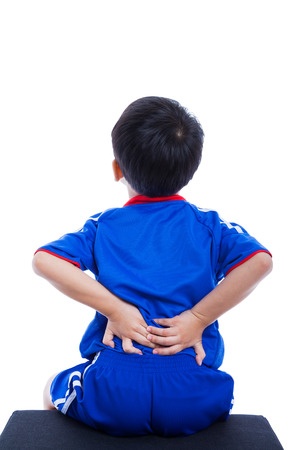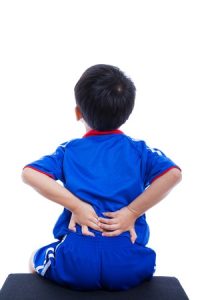
“Part of what makes an athlete an athlete is the ability to play through pain.” DO YOU AGREE? This statement was made by Brian P. McKeon, Boston Celtics chief medical officer during an interview.
Staggering Statistics

According to the CDC (Centers for Disease Control and Prevention), high school athletes alone account for an estimated 2 million injuries, 500,000 doctor visits and 30,000 hospitalizations every year. Another 3.5 million children under the age of 14 receive medical treatment for sports injuries each year.
A new study by national research group Safe Kids Worldwide may help explain why a child is taken to the emergency room for a sports injury every 25 seconds. The study revealed how young athletes are engaged in a dangerous culture, comprised of ignoring sports injuries and feeling pressured to play even when they know they have been injured.
3,000 athletes, coaches, and parents were surveyed as part of this research. Results indicated some very troubling statistics:
- 42 percent of young athletes claimed to have downplayed or hidden injuries in an effort to remain in the game and not risk being kicked off a team
- 53 percent of coaches said they have felt pressure to knowingly put injured players back in a game
- 62 percent of organized sports-related injuries occur during practice
- 33 percent of parents do not have their children take the same safety precautions at practice that they would during a game
- Roughly the same percentage of young athletes claimed it was “normal” to play rough during a game, in effect “sending a message” to the opposing team
While such problems in youth sports have been well publicized, this new research found that many young athletes are still putting themselves at unnecessary risk. Bob Ferraro, Senior CEO of the National High School Coaches Association, has this to say on the topic: “One of the biggest problems with youth sports is that they are unregulated. The National High School Coaches Association believes that there should be a standardization of rules that protect our young athletes when it comes to injuries….”
Pushing With Pressure
“Kids younger and younger are facing more pressure, and they are overdoing it and potentially causing long-term problems,” said Dr. Mitch Robinson, a former University of Colorado tennis player and an orthopedic surgeon specializing in sports medicine at Panorama Orthopedics & Spine Center in Golden. “We want to get the message out that we as parents and coaches need to be more aware of the potential risks and know when young athletes need to rest and seek treatment.” Robinson further expands upon this subject, explaining how the bodies of younger athletes are still “skeletally immature”, placing them at different risks than adults, most notably the dangers of repetitive wear and tear without sufficient recovery time.
“We want to get the message out that we as parents and coaches need to be more aware of the potential risks and know when young athletes need to rest and seek treatment.” Robinson further expands upon this subject, explaining how the bodies of younger athletes are still “skeletally immature”, placing them at different risks than adults, most notably the dangers of repetitive wear and tear without sufficient recovery time.
The cultural message to play through pain is strong, claims Dr. Samantha O’Connell, a clinical psychologist who specializes in treating athletes. Kids are under pressure to play at a much higher level and with more intensity than they did decades ago. A pitcher who shows potential may play on two or three different teams during a single season.
As a result, pediatric orthopedic surgeons are seeing a disproportionate number of young athletes sustaining injuries as they continue to play through pain. “High school athletes, especially freshmen, can’t always distinguish between the everyday soreness from workouts and practice and serious injury,” says Jeri Connor, a high school athletic trainer with 20 years of experience.
Is Coach Enhancing Capability or Fostering Disability?
The good new is, according to the CDC, more than half of all sports injuries in children are preventable. We just need to make some changes. This begins with the parents of young athletes. Parents have the right to know a coach’s credentials and experience levels, and to question coaches and trainers when it comes to a child’s health, safety, and wellbeing. If a parent fears that a coach will not play his child if he questions his or her training methods, it is time to seek out a new coach.
There is often a concern on the part of a parent over merely suggesting to the coach that a child needs to rest or recover from a potential injury, for fear of the coach’s reaction. Again, this is a red warning flag that he or she is the wrong coach for your budding athlete. Misconceptions about sports safety, on the part of both coaches and parents, are contributors to overuse injuries.
Continuing to play through an injury can exacerbate an already tenuous situation, placing a young athlete at a higher risk of sustaining another injury elsewhere in his body. Unfortunately, nearly 90% of parents tend to underestimate the amount of rest/recovery time required to fully heal a young body.
The Role of Parents
Parents, coaches, and athletic trainers can help teammates avoid injuries by teaching proper body mechanics techniques, and also by setting age-appropriate goals for their sports players. Dr. Carolyn Kienstra, a pediatrician at the University of Miami Health System who practices at Holtz Children’s Hospital, reminds the public, “Don’t expect a 10-year-old to play like a high school senior.”
If trainers and coaches observe a fierce drive and passion in a student-athlete, there is a tendency to want to push him to his fullest potential. It is up to the responsible parents in such a child’s life to pay attention, and know when to call a halt to a dangerous situation. Along with praising a child’s determination and budding skills, be savvy enough to encourage a young athlete to stop playing as soon as he notices an injury, and seek out his coach or doctor. If prescribed, adhere to the schedule of rest and recovery until the doctor determines that an injury has fully healed. Student-athletes can help this process along by paying attention to sports nutrition, consuming healthy foods and plenty of fluids, not just during the game season but every day.
If prescribed, adhere to the schedule of rest and recovery until the doctor determines that an injury has fully healed. Student-athletes can help this process along by paying attention to sports nutrition, consuming healthy foods and plenty of fluids, not just during the game season but every day.
It Is Not Just Child’s Play
These same sensibilities apply to adults. Whether your client is a regular at the gym, or more of a weekend warrior, both you and he are no doubt acquainted with the old adage, “No pain, No gain”. In an effort to increase our levels of fitness, we often strive to out-perform what we accomplished during our last workout, raising the amount of weight we lifted or spending just a few more minutes on the treadmill. If we’re sore the next day, we reason that we must have done things properly. If not, we figure that we probably didn’t work hard enough. Sound familiar?
Recently a few of my clients have mentioned to me that they were not sore the day or two after our training session and that perhaps they were not tapping into their fullest potential. This is a myth that has been perpetuated far too long. While it is true that a strenuous workout may render you a bit sore and stiff the next day, it is not necessary to experience these sensations as you make great strides towards your fitness goals.
Understanding The Body’s Mechanisms
When an individual who is deconditioned embarks upon a new workout regimen, there may be an increase in delayed-onset muscle soreness. This is due in large part to the fact that muscle groups which have never before been challenged are suddenly being asked to perform a new set of movements, with the addition of “time under tension”. However, a seasoned athlete who changes his training every month or so probably will not feel this same acute level of discomfort, even if his weight load has been dramatically increased. A more conditioned body has firmly established neural pathways in place as well as highly developed musculature; as such, it will take quite a bit more leverage to elicit discomfort in such an individual.
Progress can be measured in several ways when assessing the success of a fitness program. Painless gains include such aspects as increases in self-efficacy, ease of movement through activities of daily living, heightened levels of energy, and an overall improvement in mood and self-esteem. It is these factors that will maximize adherence to a workout program, and that is the first step toward success and visible gains. If a little pain comes along for the ride at first, know that it is only temporary. If your clients don’t experience post-workout soreness, assure them that their bodies are still responding in a very positive manner!
[info type=”facebook”]Are you or clients coping with pain? If you’re an NFPT trainer, join the Facebook Community Group to chat with other trainers. If you’re not, come talk with NFPT here, we would like to meet you.[/info]
REFERENCES
- https://breakingmuscle.com/fitness/stop-playing-through-pain-how-to-safeguard-youth-athletes
- https://www.bostonglobe.com/lifestyle/health-wellness/2012/09/30/playing-through-pain/64tamog9T1KqLbopctWL8J/story.html
- http://journals.humankinetics.com/doi/abs/10.1123/jcsp.7.1.41
- https://choices.scholastic.com/story/playing-through-pain
- https://choices.scholastic.com/issues/04_01_15/Broken-Athletes
- http://www.miamiherald.com/living/health-fitness/article36510735.html
- https://www.today.com/health/teens-playing-through-pain-not-taking-sports-injuries-seriously-says-1D80274256
- http://kidshealth.org/en/teens/play-injury.html
- http://advancingyourhealth.org/orthopedics/2012/05/21/athletic-injuries-young-athletes-play-through-pain/
- https://www.safekids.org/around-world






